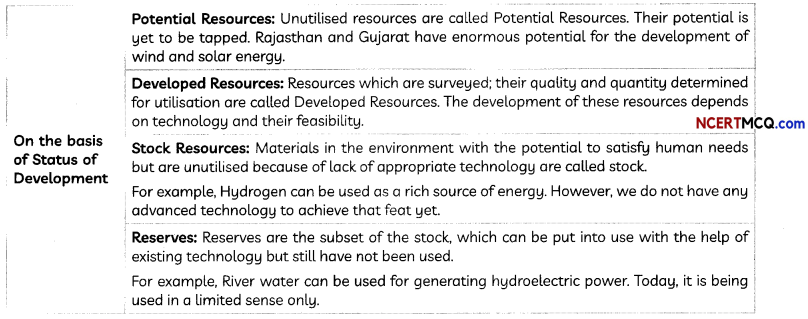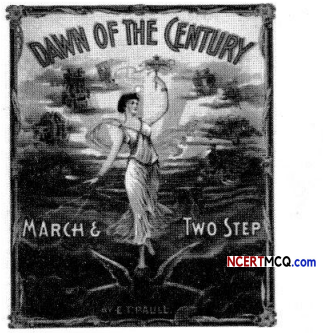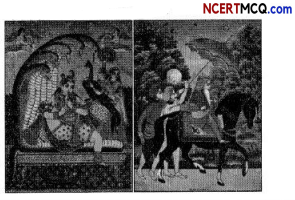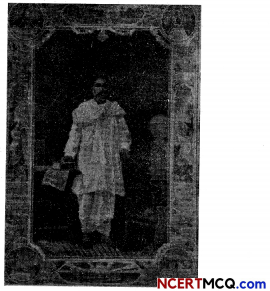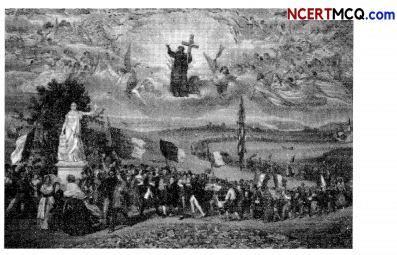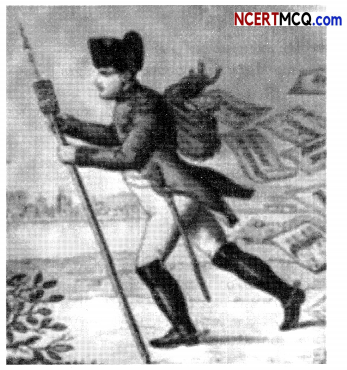Minerals and Energy Resources Class 10 Notes Social Science Geography Chapter 5
Minerals and Their Significance
People use metals to create different products everyday. The metals are made of different minerals embedded in the rocks. Metals are extracted from these minerals after proper refinement.
Thus, minerals have become an indispensable part of our lives.
Almost everything used every day is created out of minerals. The railway lines, tarmac (paving) of the roads, our implements and even the machinery are made from minerals.
Cars, buses, trains, aero planes are manufactured from minerals and run on power resources derived from the earth. Even our food contains minerals. Human beings have used minerals for their livelihood, decoration, festivities, religious and ceremonial rites in all stages of development.
![]()
Important:
- Abrasive minerals like silica, limestone, aluminum oxide and various phosphate minerals form the contents of a toothpaste. Fluoride reduces cavities and comes from a mineral fluorite.
- Toothpastes also contain titanium oxide, which comes from minerals called rutile, ilmenite and anatase and makes the toothpaste white.
- The sparkle in toothpastes is from mica. The toothbrush and tube containing the paste are made of plastics from petroleum.
Life processes cannot occur without minerals. Our mineral intake represents onLy about 0.3 per cent of our total intake of nutrients, they are potent enough to render the other 99.7 per cent of foodstuffs useless.
Minerals can be defined as homogenous, naturally occurring substances with a definable internal structure. Minerals are found in varied forms in nature- at times, hard like the diamond and at times, soft like the talc.
Rocks are combinations of homogeneous substances called minerals. Limestone consists of a single mineral only, most rocks consist of several minerals in varying proportions. Few are abundantly found while the rest are rare.
Formation of a particular mineral depends upon the physical and chemical conditions under which the material forms. Thus, minerals come in a wide range of colours, hardness, crystal forms, luster and density. Geologists use these properties to classify the minerals.
Minerals are classified in various categories.
Important:
Geographers study minerals as part of the earth’s crust for a better understanding of landforms and economic activities associated with them. A geologist studies the formation of minerals, their age and physical and chemical composition.
Mode of Occurrence of Minerals
Minerals are usually found in “ores”. The term is used to describe an accumulation of any mineral mixed with other elements. It is necessary that the mineral content of the ore be in sufficient concentration to make its extraction commercially viable. The type of formation or structure in which they are found determines the relative ease with which mineral ores may be mined. The cost of extraction also depends on this.
![]()
Minerals generally occur in the following forms:
1. In igneous and metamorphic rocks, minerals occur in the cracks, crevices, faults, or joints.
The smaller occurrences are called veins and the larger are called lodes. Generally, these are formed when minerals in liquid/molten and gaseous forms are forced upward through cavities towards the earth’s surface. They cool and solidify as they rise. Metallic minerals like tin, copper, zinc and lead are obtained from veins and lodes.
2. In sedimentary rocks, minerals occur in beds or layers as a result of deposition, accumulation and concentration in horizontal strata. They accumulate over long periods under great heat and pressure. For example, coal and iron ore are sedimentary rocks formed in this way.
Important:
Few sedimentary rocks are gypsum, potash salt and sodium salt. These are formed as a result of evaporation especially in arid regions.
- Another way of formation involves decomposition of surface rocks, removal of soluble constituents, leaving a residual mass of weathered material containing ores. For example, bauxite.
- Minerals occur in alluvial deposits in sands of valley floors and base of hills. These deposits are called ‘placer deposits’ and generally contain minerals which cannot be corroded by water.
For example, gold, silver, tin and platinum. - Ocean waters contain vast quantities of minerals. They are too diffused to be useful economically. Common salt, magnesium and bromine are derived from ocean waters. The ocean beds are rich in manganese nodules.
Important:
- Most minerals in India are nationalised; this means their extraction is possible only after obtaining due permission from the government.
- In tribal areas of northeast India, minerals are owned by individuals or communities.
- Meghalaya has huge deposits of coal, iron ore, limestone and dolomite etc. Coal mining in Jowai and Cherapunjee is carried out privately through long narrow tunnels, known as ‘Rat hole’ mining.
- The National Green Tribunal has declared such activities illegal.
India has rich and varied mineral resources. They are unevenly distributed.
Peninsular rocks contain reserves of coal, metallic minerals and other non-metallic minerals.
- Sedimentary rock reserves flank the western and eastern sides of the peninsula. Gujarat and Assam host most petroleum deposits.
- Rajasthan hosts rock systems of the peninsula, where non-ferrous minerals are found.
- The vast alluvial plains of north India are almost devoid of economic minerals. Variations occur because of differences in the geological structure, processes and time involved in the formation of minerals.
![]()
Frequently Asked:
- The economic viability of a reserve depends upon the concentration of mineral in the ore, the ease of extraction, and closeness to the market.
- A mineral ‘deposit’ or ‘reserve’ turns into a mine when the extraction is carried out.
Example 1.
Minerals are deposited and accumulated in the strata of which of the following rocks?
(a) Sedimentary rocks
(b) metamorphic rocks
(c) Igneous rocks
(d) none of the above
Answer:
(a) Sedimentary rocks
Ferrous Minerals:
Ferrous minerals account for about three-fourths of the total value of the production of metallic minerals. They help in the development of metallurgical industries. India exports a good quantity of ferrous minerals.
Iron Ore:
Iron ore is the backbone of industrial development. India has abundant resources of iron ore.
- Magnetite is the finest iron ore.
- It contains a high content of iron up to 70 percent.
- It has excellent magnetic qualities which are valuable in the electrical industry.
- Hematite is an important industrial iron ore but has a slightly lower iron content than magnetite. (50-60 percent).
![]()
The major iron ore belts in India are:
1. Odisha-Jharkhand belt: High-grade hematite ore is found in Badampahar mines in the Mayurbhanj and Keonjhar districts in Odisha. Haematite iron ore is mined in Gua and Noamundi in the district of Singhbhum in Jharkhand.
2. Durg-Bastar-Chandrapur belt of Chhattisgarh and Maharashtra: Very high-grade hematite are found in the famous Bailadila range of hills in the Bastar district of Chhattisgarh. These hill ranges comprise 14 deposits of super high-grade hematite iron ore. It has the best physical properties needed for making steel. Iron ore from these mines is exported to Japan and South Korea via Visakhapatnam port.
3. Ballari – Chitradurga – Chikkamagaluru Tumakuru belt in Karnataka: This belt has large reserves of iron ore. The Kudremukh mines located in the Western Ghats of Karnataka are a 100 percent export units. Kudremukh deposits hold the largest mineral reserves in the world. The ore is transported as slurry through a pipeline to a port near Mangalore.
4. Maharashtra-Goa belt: The belt covers the Goa and Ratnagiri districts of Maharashtra. The quality of iron ore found here is not very rich, however, they have been efficiently exploited. Iron ore is exported through Marmagao port.
Important:
- Kudre in Kannada means horse. The highest peak in the western ghats of Karnataka resembles the face of a horse.
- The Bailadila hills get their name from its appearance- which resembles the hump of an ox.
Manganese:
- Manganese is mainly used in the manufacturing of steel and ferromanganese alloy.
- Nearly 10 kg of manganese is required to manufacture one tonne of steel.
- It is also used in manufacturing bleaching powder, insecticides and paints.
Non-Ferrous Minerals:
India’s reserves and production of non-ferrous minerals are not enough and satisfactory. Non- Ferrous minerals like copper, bauxite, lead, zinc, and gold play a vital role in a number of metallurgical, engineering and electrical industries.
![]()
Copper:
- India is critically deficient in reserves and the production of copper.
- Copper is mainly used in electrical cables, electronics, and chemical industries because it is malleable, ductile and a good conductor of electricity.
- The BaLaghat mines in Madhya Pradesh, Khetri mines in Rajasthan and Singhbhum district of Jharkhand are leading producers of copper.
Bauxite:
- Aluminum is extracted from bauxite.
- Bauxite deposits are formed by the decomposition of rocks rich in aluminum silicates.
- Aluminum combines the strength of metals such as iron, with qualities like extreme lightness, good conductivity and great malleability.
- India’s bauxite deposits are mainly found in the Amarkantak plateau, Maikal hills and the plateau region of Bilaspur-Katni.
Important:
- Bauxite is a day-Like substance that produces aiumina as an intermediate product and later aluminum is obtained.
- Odisha was the largest bauxite-producing state in India in 2016-17. Panchpatmali deposits in Koraput district are the most important bauxite deposits in the state.
Non-Metallic Minerals:
Mica:
Mica is made of a series of plates or leaves. It splits easily into thin sheets. It can be clear, black, green, red, yellow or brown. Mica is highly useful in electric and electronic industries. It has an excellent di-eLectric strength, low power loss factor, insulating properties and resistance to high voltage. Mica deposits are found in the northern parts of Chota Nagpur plateau. Koderma Gaya – Hazaribagh belt of Jharkhand is the leading producer.
Ajmer in Rajasthan is the main mica producing area. Nellore mica belt of Andhra Pradesh is another important mica producing area.
Example 2.
Koderma, in Jharkhand, is the leading producer of which one of the following minerals?
(a) Bauxite
(b) Mica
(c) Iron ore
(d) Copper
Answer:
(a) Bauxite
Explanation: Mica deposits are found in the northern parts of the Chota Nagpur plateau. Koderma Gaya – Hazaribagh belt of Jharkhand is the leading producer.
![]()
Example 3.
Read the source given below and answer the questions that follow:
Mica is a mineral made up of a series of plates or leaves. It splits easily into thin sheets. These sheets can be so thin that a thousand can be layered into a mica sheet of a few centimeters high. Mica can be clear, black, green, red yellow or brown. Due to its excellent di-electric strength, low power loss factor, insulating properties and resistance to high voltage, mica is one of the most indispensable minerals used in electric and electronic industries. Mica deposits are found in the northern edge of the Chota Nagpur plateau. Koderma Gaya – Hazaribagh belt of Jharkhand is the leading producer.
In Rajasthan, the major mica producing area is around Ajmer. Nellore mica belt of Andhra Pradesh is also an important producer in the country.
(A) Which of the following characteristic features of Mica makes it an ideal electric insulator?
(a) It can be split into sheets.
(b) It can be melted.
(c) It can be changed into crystals.
(d) It has good resistance to high voltage and insulating properties.
Answer:
(d) It has good resistance to high voltage and insulating properties.
(B) Which of the following areas is not a producer of Mica?
(a) Chhota Nagpur Plateau
(b) Bengal Plateau
(c) Rajasthan
(d) Andhra Pradesh
Answer:
(b) Bengal Plateau
Explanation: Mica deposits are found in the northern edge of the Chhota Nagpur plateau. Koderma Gaya – Hazaribagh belt of Jharkhand is the leading producer. In Rajasthan, Mica is produced around Ajmer. Nellore mica belt of Andhra Pradesh is also an important producer in the country.
(C) Mention one property of Mica that is different from other minerals used to make electronic equipment?
Answer:
Mica can be converted into very thin sheets.
(D) Assertion (A): Mica is made up of thin plates and sheets.
Reason (R): It is manufactured in the laboratory using a special thickening technique.
(a) Both (A) and (R) are true and (R) is the correct explanation of (A).
(b) Both (A) and (R) are true but (R) is not the correct explanation of (A).
(c) (A) is correct but (R) is wrong.
(d) (A) is wrong but (R) is correct.
Answer:
(c) (A) is correct but (R) is wrong.
Explanation: Mica is found in the form of crystals and individual mica crystals can easily be split into extremely thin elastic plates. This characteristic is described as perfect basal cleavage. They are thus converted into extremely thin sheets and stacked over each other to form mica sheets.
Rock Minerals:
Limestone is found in rocks composed of calcium carbonates or calcium and magnesium carbonates.
It is found in sedimentary rocks of most geological formations. Limestone is the basic raw material for the cement industry and essential for smelting iron ore in the blast furnace.
![]()
Frequently Asked Hazards of Mining:
- The dust and noxious fumes inhaled by miners expose them to the risk of pulmonary diseases. The risk of collapsing mine roofs, inundation and fires in coal mines are a threat.
- The water sources in the region get contaminated due to mining. Dumping of waste and slurry leads to degradation of land, soil leads to stream and river pollution.
Example 4.
Which one of the following minerals is formed by decomposition of rocks, leaving a residual mass of weathered material?
(a) Coal
(b) Bauxite
(c) Gold
(d) Zinc
Answer:
(b) Bauxite
To prevent mining from becoming a killer industry, stricter safety regulations and environmental Laws should be implemented.
Conservation of Minerals
There is a strong dependence of industry and agriculture upon mineral deposits and the substances manufactured from them. The total volume of workable mineral deposits is only one per cent of the earth’s crust.
Mineral resources which required millions of years to be created and concentrated are being consumed rapidly. The geological processes of mineral formation are slow. Rates of replenishment are infinitely small when compared to the rates of consumption. Mineral resources are infinite and non-renewable. Rich mineral deposits are short-lived possessions. Continued extraction of ores makes mineral extraction more difficult because extraction has to be done at greater depths. Ores extracted are of poor quality too.
An effort needs to be made to utilise mineral resources in a planned and sustainable manner. Improved technologies need to be evolved to allow use of low grade ores at low costs. Recycling of metals, using scrap metals and other substitutes help conserve our mineraL resources for the future.
![]()
Energy Resources
Energy is required to cook, to provide light and heat, to propel vehicles and to drive machinery in industries. Energy can be generated from fuel minerals like coal, petroleum, natural gas, uranium and from electricity.
Energy resources can be classified as conventional and non-conventional sources.
- Conventional sources include firewood, cattle dung cake, coal, petroleum, natural gas and eLectricity (both hydel and thermal).
- Non-conventional sources include solar, wind, tidal, geothermal, biogas and atomic energy. Firewood and cattle dung cakes are used in rural India. About 70 percent of the energy requirement in rural households is met by them. It is becoming difficult to continue this due to a decreasing forest area.
Important:
Dung cake consumes most valuable manure which could be used in agriculture. Hence they are being discouraged.
Conventional Sources of Energy
Conventional sources of energy are those energy sources which are non-renewable and hazardous.
Energy is produced from non-renewable sources of energy. These cannot be replaced by natural substances and takes billions of years to form.
Coal:
Coal is the most abundantly available fossil fuel in India. It is used for power generation, to supply energy to industry as well as for domestic needs. India is highly dependent on coal for meeting its commercial energy requirements. Coal is formed due the compression of plant material over millions of years. Coal is found in forms depending on the degrees of compression and the depth and time of burial.
Decaying plants in swamps produce peat.
- Peat has a low carbon and high moisture contents and low heating capacity.
- Lignite is a low-grade brown coal, which is soft with high moisture content. Lignite reserves at Neyveli in Tamil Nadu are used for the generation of electricity.
- Coal that has been buried deep and subjected to increased temperatures is called bituminous coal. It is the most popular coal for commercial use.
- Anthracite is the highest quality hard coal.
Important:
Metallurgical coal is high grade bituminous coal which has a special value for smelting iron in blast furnaces.
Frequently Asked:
- Coal occurs in rock series of two main geological ages in India.
- Condwana- they are a little over 200 million years in age and in tertiary deposits which are only about 55 million years old.
- Metallurgical coal is a huge resource of Gondwana coal. Reserves are located in Damodar valley (West Bengal- Jharkhand). Jharia, Raniganj, Bokaro are important coalfields. The Godavari, Mahanadi, Son and
- Wardha valleys also contain coal deposits.
- Tertiary coals occur in the north eastern states of Meghalaya, Assam, Arunachal Pradesh and Nagaland.
Heavy industries and thermal power stations are located on or near the coalfields.
![]()
Important:
Coal is a bulky material, which loses weight on use as it is reduced to ash.
Petroleum:
Petroleum or mineral oil is an important source of energy. Petroleum provides fuel for heat and lighting, lubricants for machinery and raw materials for industries. Petroleum refineries are nodal industries for synthetic textile, fertiliser and numerous chemical industries.
Petroleum occurrences in India are found in anticlines and fault traps in the rock formations of the tertiary age. In regions of folding, anticlines or domes, it occurs where oil is trapped in the crest of the upfold. The oil bearing layer is a porous limestone or sandstone through which oil may flow. The oil is prevented from rising or sinking by intervening non-porous layers.
Petroleum is also found in fault traps between porous and non-porous rocks. Gas being lighter floats above the oil.
- Mumbai High, Gujarat and Assam are major petroleum production areas in India.
- Ankeleshwar is the most important oil field in Gujarat.
- Assam is the oldest oil producing state of India. Digboi, Naharkatiya and Moran-Hugrijan are the important oilfields in the state.
Natural Gas:
Natural gas is an important clean energy resource found in association with or without petroleum. It is used as a source of energy as well as an industrial raw material in the petrochemical industry. Natural gas is considered an environment-friendly fuel because of low carbon dioxide emissions and is, therefore, the fuel for the present century.
- Large reserves of natural gas have been discovered in the Krishna-Godavari basin. Along the west coast, the reserves of the Mumbai High and allied fields are supplemented by finds in the Gulf of Cambay.
- Andaman and Nicobar islands are also important areas having large reserves of natural gas.
- The 1700 km long Hazira-Vijaipur-Jagdishpur cross country gas pipeline links Mumbai High and Bassein with the fertilizer, power and industrial complexes in western and northern India.
- This artery has provided an impetus to India’s gas production. The power and fertilizer industries are the key users of natural gas. Use of Compressed Natural Gas (CNG) for vehicles to replace liquid fuels is gaining wide popularity in the country.
![]()
Electricity:
Per capita consumption of electricity is considered as an index of development for any country. Electricity is generated by running water which drives hydro turbines to generate hydro-electricity. Electricity is also generated by burning other fuels such as coal, petroleum and natural gas to drive turbines to produce thermal power.
Important:
- Hydroelectricity is generated by fast-flowing water, which is a renewable resource.
- India has a number of multi-purpose projects like Bhakra Nangal, Damodar Valley corporation, Kopili Hydel Project etc., which produce hydroelectric power. Thermal electricity is generated by using coal, petroleum and natural gas. The thermal power stations use non-renewable fossil fuels for generating electricity.
Non-Conventional Sources of Energy:
India is becoming increasingly dependent on fossil fuels such as coal, oil and gas for energy. Rising prices of oil and gas and their potential shortages threaten security of energy supply in future and also have serious repercussions on the growth of the national economy.
Use of fossil fuels cause serious environmental problems. Use of renewable energy sources like solar energy, wind, tide, biomass and energy from waste material is imperative. These are called non- conventional energy sources. India has an abundance of sunlight, water, wind and biomass and has programmes for the development of these renewable energy resources.
Nuclear or Atomic Energy:
- Nuclear energy is obtained by altering the structure of atoms. Most energy released in the form of heat when alteration is made helps generate electric power.
- Uranium and Thorium, available in Jharkhand and the Aravalli ranges of Rajasthan are used for generating atomic or nuclear power.
- The Monazite sands of Kerala are also rich in Thorium.
Example 5.
Which one of the following minerals is contained in the Monazite sand?
(a) Oil
(b) Uranium
(c) Thorium
(d) Coal
Answer:
(c) Thorium
![]()
Solar Energy:
- India is a tropical country with an enormous supply of solar energy. Photovoltaic technology converts sunlight directly into electricity.
- Solar energy has been gaining popularity in rural and remote areas.
- Solar power plants have been established in different parts of India to minimize the dependence of rural households on firewood and dung cakes,
- This helps in environmental conservation and an adequate supply of manure in agriculture.
Wind power:
- India has immense untapped potential for wind power.
- In Tamil Nadu, from Nagercoil to Madurai, a huge wind cluster has been established for this purpose. Andhra Pradesh, Karnataka, Gujarat, Kerala, Maharashtra and Lakshadweep have important wind farms.
- Nagarcoil and Jaisalmer have been able to use their wind energy very effectively.
Biogas:
Shrubs, farm waste, animal and human waste produce biogas for domestic consumption in rural areas. Their decomposition yields gas with higher thermal efficiency in comparison to kerosene, dung cake and charcoal.
Biogas plants are set up at municipal, cooperative and individual levels.
The plants which use cattle dung, called ‘Gobar gas plants’ in rural India, provide twin benefits to the farmer:
- in form of energy
- improved quality of manure.
Biogas uses cattle dung most efficiently. It prevents the loss of trees and manure due to burning of fuelwood and cow dung cakes.
Tidal Energy:
Oceanic tides generate electricity in the following ways:
- Floodgate dams are built across inlets.
- During high tide, water flows and gets trapped in the inlet when the gate is closed.
- After the tide falls outside the flood gate, the water retained by the floodgate flows back to the sea via a pipe that carries it through a power-generating turbine.
The Gulf of Khambhat, the Gulf of Kachchh in Gujarat on the western coast and Gangetic delta in Sundarban regions of West Bengal provide ideal conditions for utilising tidal energy in India.
Geo-Thermal Energy:
Geo-thermal energy is the heat and electricity produced by using the heat from the interior of the Earth. Its source is the Earth which grows progressively hotter with increasing depth.
Groundwater in areas with shallower depth and higher temperatures absorbs heat from the rocks and becomes hot. It is hot enough to turn into steam as it rises to earth’s surface. It drives turbines and generates electricity.
![]()
Important:
Where the geothermal gradient is high, high temperatures are found at shallow depths. There are several hundred hot springs in India, which could be used to generate electricity.
Frequently Asked:
- Two experimental projects have been set up in India to harness geothermal energy.
- One is located in the Parvati valley near Manikarn in Himachal Pradesh and the other is located in the Puga Valley, Ladakh.
Conservation of Energy Resources
Energy is a basic requirement for economic development. Every sector of the national economy – agriculture, industry, transport, commercial and domestic – needs inputs of energy. The economic development plans implemented since independence need a large amount of energy to remain operational. This has increased the consumption of energy in all forms all over the country.
A sustainable path of energy development is urgently needed.
Important:
Promotion of energy conservation and increased use of renewable energy sources are the twin planks of sustainable energy.
India is presently one of the least energy-efficient countries in the world. It is imperative to adopt a cautious approach for the judicious use of energy resources.
- This can be done using public transport systems instead of individual vehicles
- This can also be done by switching off electricity when not in use.
- Another option is by using power-saving devices and using non-conventional sources of energy. Energy saved is energy produced.
→ Ores: Naturally occurring solid materials through which metals and minerals are extracted. Homogeneous: Constituting similar parts or quality or nature throughout.
→ Ferrous: Includes or contains iron.
![]()
→ Anthracite: Highest quality hard coal.
→ Lodes: Larger occurrence of igneous or metamorphic rocks or minerals in cracks or crevices. Slurry: Mixture of solid denser than water in liquid.
→ Kudre: Horse in the Kannada language.
→ Thermal Energy: Energy generated and measured by heat.
→ Gobar Gas Plant: Biogas plants that use cattle dungs to generate energy.
→ Non-porous: A surface that does not allow any kind of liquid or gas to pass through it.



